
The Windsor Road Baptist Church, Red Hill
[Photograph by Geoffrey Cox (January 2004)]

The Windsor Road Baptist Church, Red Hill
[Photograph by Geoffrey Cox (January 2004)]
Historical and Technical Documentation by Geoffrey Cox
© OHTA 2012, 2014 (last updated July 2014)
The Windsor Road Baptist congregation was established in 1877, the same year as that in which the Queensland Baptist Association was formed. Alongside the South Brisbane congregation, this was one of the earliest to separate out from the Wharf Street Baptist Church in Brisbane.1 The present wooden church was opened in 1888, built in Victorian Gothic style to the design of John Beauchamp Nicholson, who had set up his practice as an architect in Brisbane only a few years earlier in 1885.2

The Windsor-Road Baptist Church, Red Hill
[Photograph by Howard Baker (1990s)]
First Organ.
The first organ in this location was opened in 1925, built by Whitehouse Bros of Brisbane.3 It was removed to the residence of Ken Dun, Belmont around 1991.4
Present Organ.
The earliest pipework of the present organ in this church dates from an organ built by Mr E.J. (Joe) Peel for his residence in Vulture Street, South Brisbane. It has been stated that Peel built the instrument in 1934,5 but a newspaper report at the time of Peel's death in February 1953 suggests it may have been around a decade later:
EARLY COACH BUILDER DIES
Pioneer coach and motor body builder, the late Mr. E. J. Peel, will be buried at South Brisbane cemetery today. Mr. Peel died on Monday, aged 83.
Born in Cumberland, England, Mr. Peel arrived in Brisbane when 15. With his father he founded the business of Peels Ltd.
Mr. Peel, an accomplished organist, studied under the late Seymour Dicker and the late George Sampson, both of whom were organists at the old St. John's Cathedral.
After his retirement at 70 he built a pipe organ and installed it in his home. Failing eyesight prevented his playing five years ago, and the organ is now in the Toowoomba Lutheran Church.6
Peel's instrument was removed from South Brisbane in 1948 by Walter Emerson, and installed in 1949 in the north transept of the Redeemer Lutheran Church, Neil Street, Toowoomba.7
The original specification, together with a photograph of Mr Peel standing beside the organ, has survived in the Catholic Archives at St Stephen's Cathedral, Brisbane. The key action was described as 'partly pneumatic and mechanical' while the pedal organ used entirely pneumatic action.8
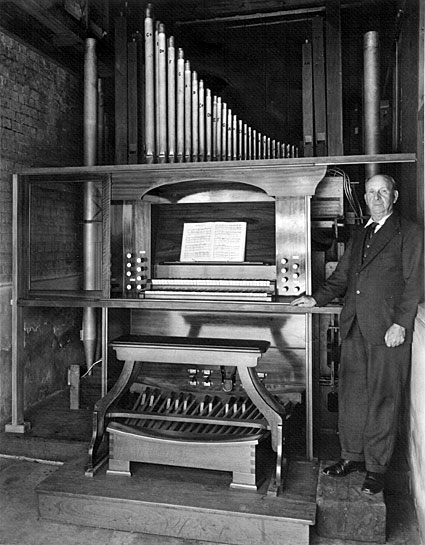
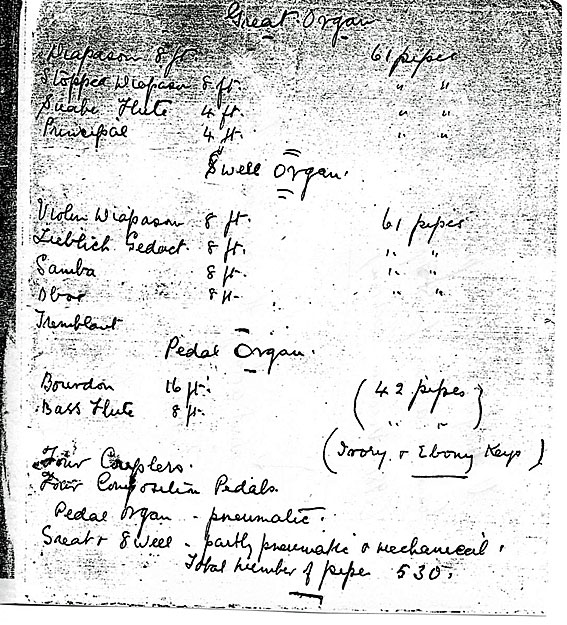
Mr E.J. Peel with his residence organ in South Brisbane
and accompanying specification
[Photographs from Brisbane Archdiocesan Archives]
Peel obtained all the original metal pipes from Palmer of London, but he made the wooden pipes himself. As a coach maker, he had access to the finest timbers: His console was of very substantial construction, made from American Walnut, while the Stopped Diapason 8ft, Lieblich Gedact 8ft and Suabe Flute 4ft were all of red cedar. Red Cedar was also used for the front of the swell box and the bellows. The keys were of thick solid ivory and unstained ebony. Mr Peel is reported also to have constructed a pedal Principal 8ft stop for the organ, which was never installed. This stop was acquired by H.W. Jarrott around 1957 and incorporated in his rebuild at St Paul's Lutheran Church, Toowoomba.9
The original specification comprised 10 speaking stops and 4 couplers, as follows:
| GREAT Diapason Stopped Diapason Principal Suabe Flute SWELL Violin Diapason Lieblich Gedact Gamba Oboe PEDAL Bourdon Bass Flute COUPLERS Great to Pedal Swell to Pedal Swell to Great Swell Octave |
8 8 4 4 8 8 8 8 16 8 |
A A |
Swell tremulant
Mechanical & pneumatic action (manuals)
Pneumatic action (pedal)
4 composition pedals
Compass: 61/30.10
Very little of Mr Peel's organ remains. The original Swell and Great soundboards were replaced around 1964 by Walter Emerson, who rebuilt the instrument with electro-pneumatic action and moved it in from the transept to the gallery of the old Redeemer Lutheran Church. At the same time, a new stop-key console was provided. Two stops (Flautina 2ft & Mixture III) were added to the Great, and the Suabe Flute 4ft was transferred to the Swell.
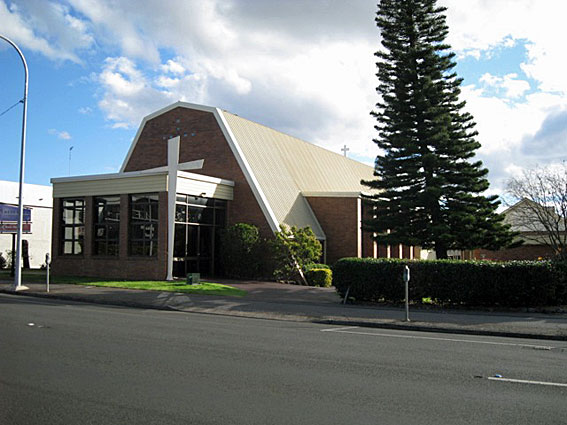
The present Redeemer Lutheran Church, Neil Street, Toowoomba,
where the organ existed between 1979 and 1990
[Photograph by Geoffrey Cox (July 2012)]
When the organ was installed in the new Redeemer Lutheran Church on the same site in 1979, Emerson added a further three manual stops, all obtained from Fincham in Melbourne. At the same time, the Suabe Flute 4ft was returned to the Great together with the original Swell Gamba 8ft (which was made available also on the Pedal), and the 1964 Flautina 2ft (a secondhand stop of unknown origin) was transferred from the Great to the Swell.
Emerson increased the scale of the Pedal Bourdon by adding five new bottom pipes, and extended this rank to provide additional pedal stops at 5-1/3ft and 4ft pitch.11

The organ in the Windsor-Road Baptist Church, Red Hill
[Photograph by Howard Baker (1990s)]
The organ was removed from Toowoomba in 1990 and installed in its present location in 1991 by H.W. Jarrott and Darryl Skerman, with the assistance of church volunteers. New casework was supplied at the time. In 1993, Australian Pipe Organs of Melbourne carried out tonal adjustments designed to integrate better the original pipework with Emerson's additions: The scales of the Great Open Diapason 8ft and Principal 4ft were increased by four pipes and two pipes respectively; the Mixture was re-constituted; and the Great flues were re-voiced. At the same time, the top half of the original Swell Gedact 8ft (from middle C upwards), which had been partially water damaged in transit to Brisbane from Toowoomba, was replaced with a metal Chimney Flute. The top part of the 1979 Swell Gemshorn 4ft (from middle F upwards) was also replaced, using less tapered pipes.12

The 1964 console built by Walter Emerson of Toowoomba
[Photograph by Howard Baker (1990s)]
The specification by 1993 was as follows:
| GREAT Open Diapason Stop Diapason Gamba Principal Suabe Flute Fifteenth Mixture SWELL Violin Diapason Chimney Flute Gemshorn Flautina Larigot Oboe PEDAL Bourdon Bass Flute Gamba Quint Octave Flute COUPLERS Great to Pedal Swell to Pedal Swell to Great Swell Octave Swell to Great Sub Swell to Great Super |
8 8 8 4 4 2 III 8 8 4 2 1-1/3 8 16 8 8 5-1/3 4 |
A B B A B B |
[originally on Swell] [1979] [1964] [upper half 1993] [1979/1993] [1964; originally on Great] [1979; originally 'Sifflute', re-named in 1993] [1979] [1979] [1964] [1964] |
Swell tremulant
Detached stop-key console
Electro-pneumatic action
4 composition pedals
Compass: 61/30.13
The instrument was considerably damaged in November 2006 when a freak storm partially unroofed the church.14 Following assessment of the damage, the organ was rebuilt and enlarged in 2007-08 by Ian Brown and Associates of Ballina. A new draw-stop console was provided, modified from a Compton Electrone (originally at the Church of Christ, Ann Street), with solid-state switching and an adjustable capture system. The Great Mixture III was reconstituted to become a Tierce Mixture in the upper register. Additions were made to the Pedal by extension, including a Peterson electronic Major Bass 16ft, the bass octave of which (at softer volume) also serves to provide the bottom notes of the extended Gamba rank.15
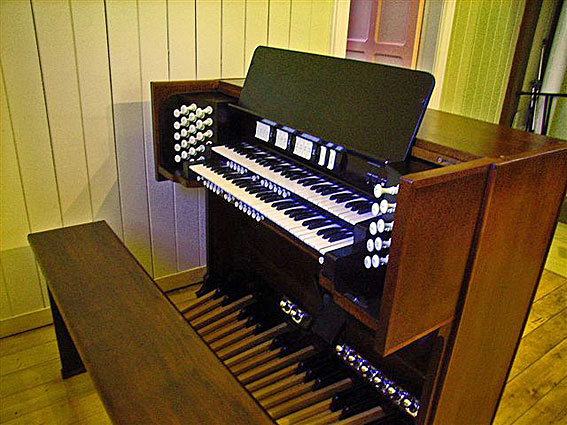
Drawstop console supplied at the time of the 2007-08 rebuild
[Photograph supplied by Darryl Skerman (2014)]

Façade pipes repainted at the time of the 2007-08 rebuild
[Photograph supplied by Darryl Skerman (2014)]
Provision has been made for the addition of further stops, and some pipework from the organ at the Uniting Church, Indooroopilly, which was broken up late in 2009, has been purchased for this purpose.16
The current specification of 22 stops, with provision for another 6 to be added, is as follows:
| GREAT Contra Gamba Open Diapason Stopped Diapason Gamba Principal Suabe Flute Fifteenth Mixture [Trumpet] |
16 8 8 8 4 4 2 III [8] |
A A [B] |
[2008; electronic bass] [originally on Swell] [1979] [1964; reconfigured 2008 to include tierce] [prepared for] |
| SWELL Violin Diapason Chimney Flute [Voix Célestes II] Gemshorn Flautina Larigot [Double Trumpet] [Trumpet] Oboe |
8 8 [8] 4 2 1-1/3 [16] [8] 8 |
[B] [B] |
[upper half 1993] [prepared for] [1979/1993] [1964; originally on Great] [1979, originally 'Sifflute', re-named in 1993] [prepared for] [prepared for] |
| PEDAL Subbass Major Bass Bourdon Contra Gamba [Principal] Bass Flute Gamba Octave Flute Gambette [Double Trumpet] |
32 16 16 16 [8] 8 8 4 4 [8] |
C C A C A C A [B] |
[2008] [acoustic] [2008; electronic] [2008, electronic bass] [prepared for] [1979] [2008] [prepared for] |
| COUPLERS Great to Pedal Great Octave to Pedal Swell to Pedal Swell Octave to Pedal Swell Sub Octave Swell Octave Swell Unison Off Swell to Great Sub Swell to Great Swell to Great Super Great Octave |
[2008] [2008] [2008] [2008] [1964] [1964] [2008] |
Swell tremulant
Detached draw-stop console
Electro-pneumatic action
6 combination thumb pistons to Great
6 combination thumb pistons to Swell
6 combination toe pistons to Pedal
10 general combination thumb pistons
Great and Pedal combinations combined
Swell to Great reversible thumb piston
Great to Pedal reversible thumb piston
Swell to Pedal reversible thumb piston
Swell to Great reversible toe piston
Great to Pedal reversible toe piston
Compass: 61/32.17
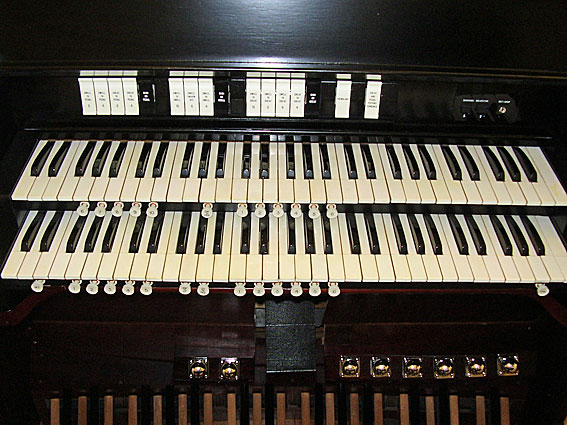

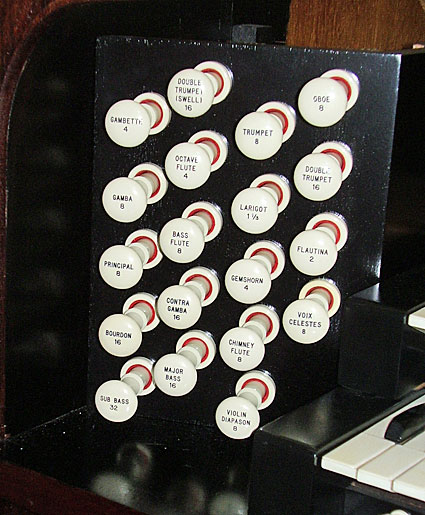
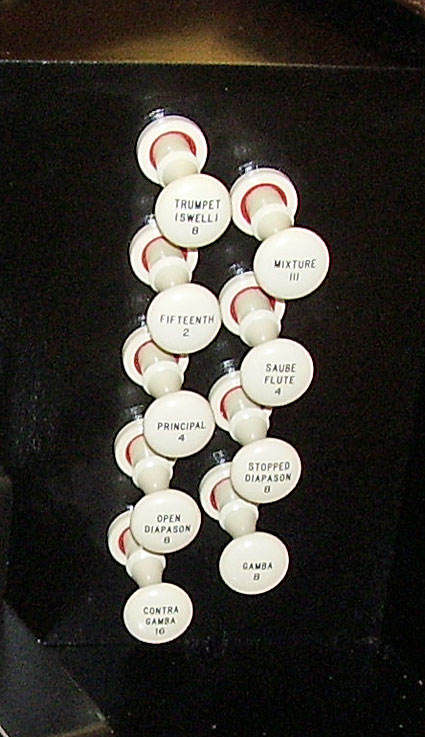
Console details
[Photographs supplied by Darryl Skerman (2014)]
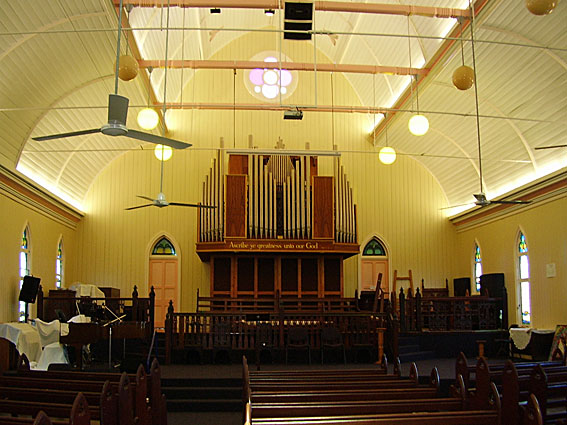
General view of the church interior
[Photograph supplied by Darryl Skerman (2014)]
___________________________________________________________
1 John E. White, A Fellowship of Service: A History of the Baptist Union of Queensland 1877-1977 (Brisbane: Baptist Union of Queensland, c.1977), p. 64.
2 Donald Watson & Judith McKay, Queensland Architects of the 19th Century: A Biographical Dictionary (Brisbane: Queensland Museum, 1994), pp. 130-31.
3 The Brisbane Courier (17 June 1925), pp. 22-23; Whitehouse Bros Ledger (1922-1940), p. 121.
4 Darryl A. Skerman, 'The Organs of the Windsor Road Baptist Church,' The Organ Voice, vol. 22, no. 1 (Autumn 1996), p. 42.
5 Original builder and location supplied by Walter Emerson, Toowoomba, February 1974. Date 1934 from Skerman, op. cit., p. 42.
6 The Courier-Mail (4 February 1953), p. 6.
7 Personal communication to G.Cox from Walter Emerson, February 1974.
8 Catholic Archives, Archdiocese of Brisbane: BAA St Stephen's Choir Box file. See also: Geoffrey Cox, 'A Residence Organ built by Mr E.J. Peel, Coachmaker of South Brisbane,' Organ Australia, vol. 6, no. 4 (December 2010), pp. 11-13.
9 Personal communication to G. Cox from Leslie W. Rub, 3 October 1988.
10 Catholic Archives, Archdiocese of Brisbane: BAA St Stephen's Choir Box file. Names of the couplers deduced from later sources. The specification given by Darryl Skerman, 1996, op. cit., does not agree with this early source.
11 Personal communication to G. Cox from Leslie W. Rub, 3 October 1988.
12 Skerman, 1996, op. cit., pp. 42-45.
13 Specification noted by G. Cox, February 1974. Subsequent details provided by Leslie W. Rub (1988) and from Skerman, 1996, op. cit.
14 [Darryl Skerman], 'Windsor Road Baptist Church, Red Hill, Qld, damaged in storm,' Organ Australia, vol. 2, no. 1 (March 2007), p. 12.
15 [Darryl Skerman], 'Windsor Road Baptist Church: The Organ,' (privately printed brochure, c.2010); see also: The Sydney Organ Journal, vol. 39, no. 2 (Autumn 2008), p. 33.
16 Personal communication to G. Cox from David Cahill, April 2010.
17 Specification from [Skerman], c.2010, op. cit., with additional information recorded above.